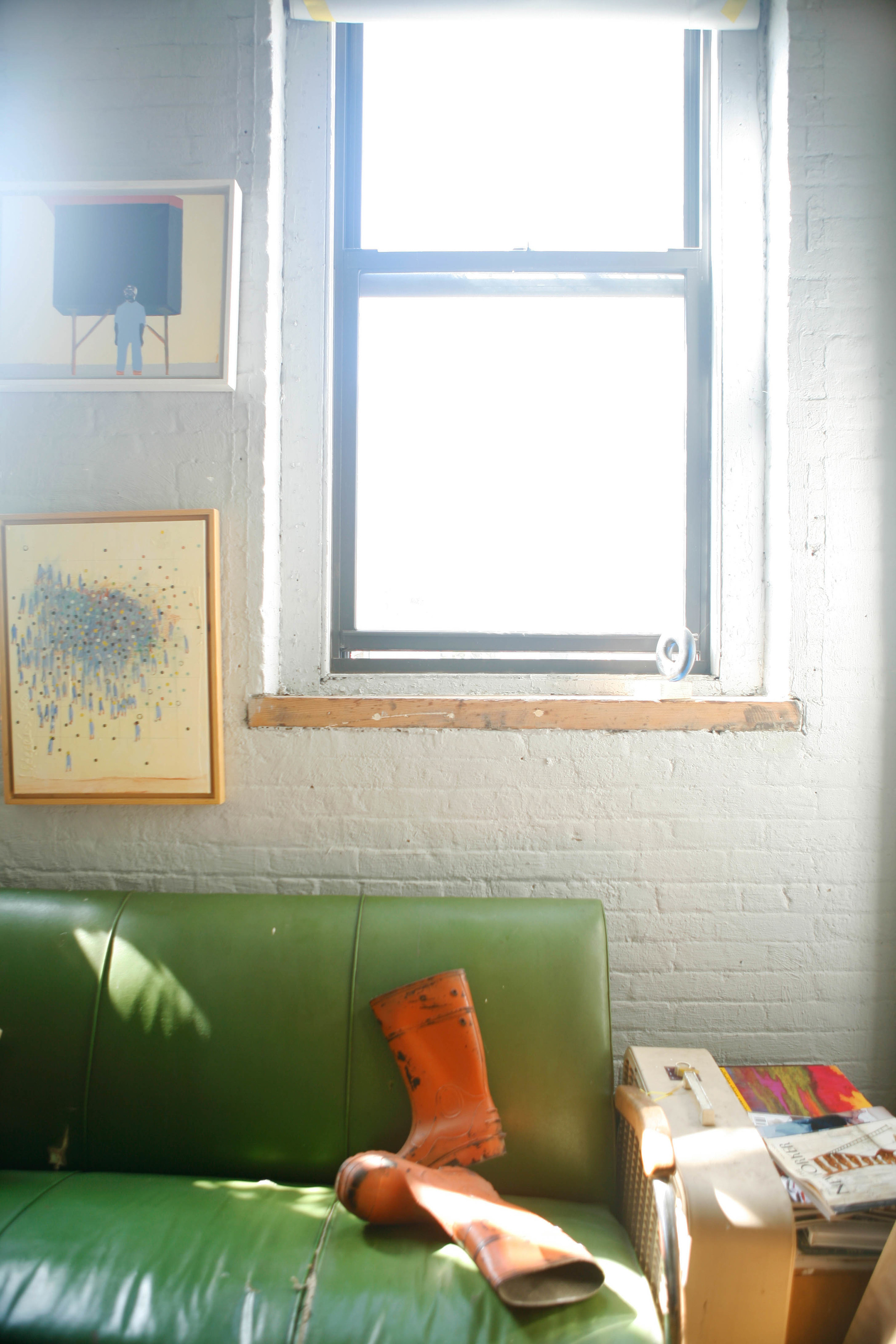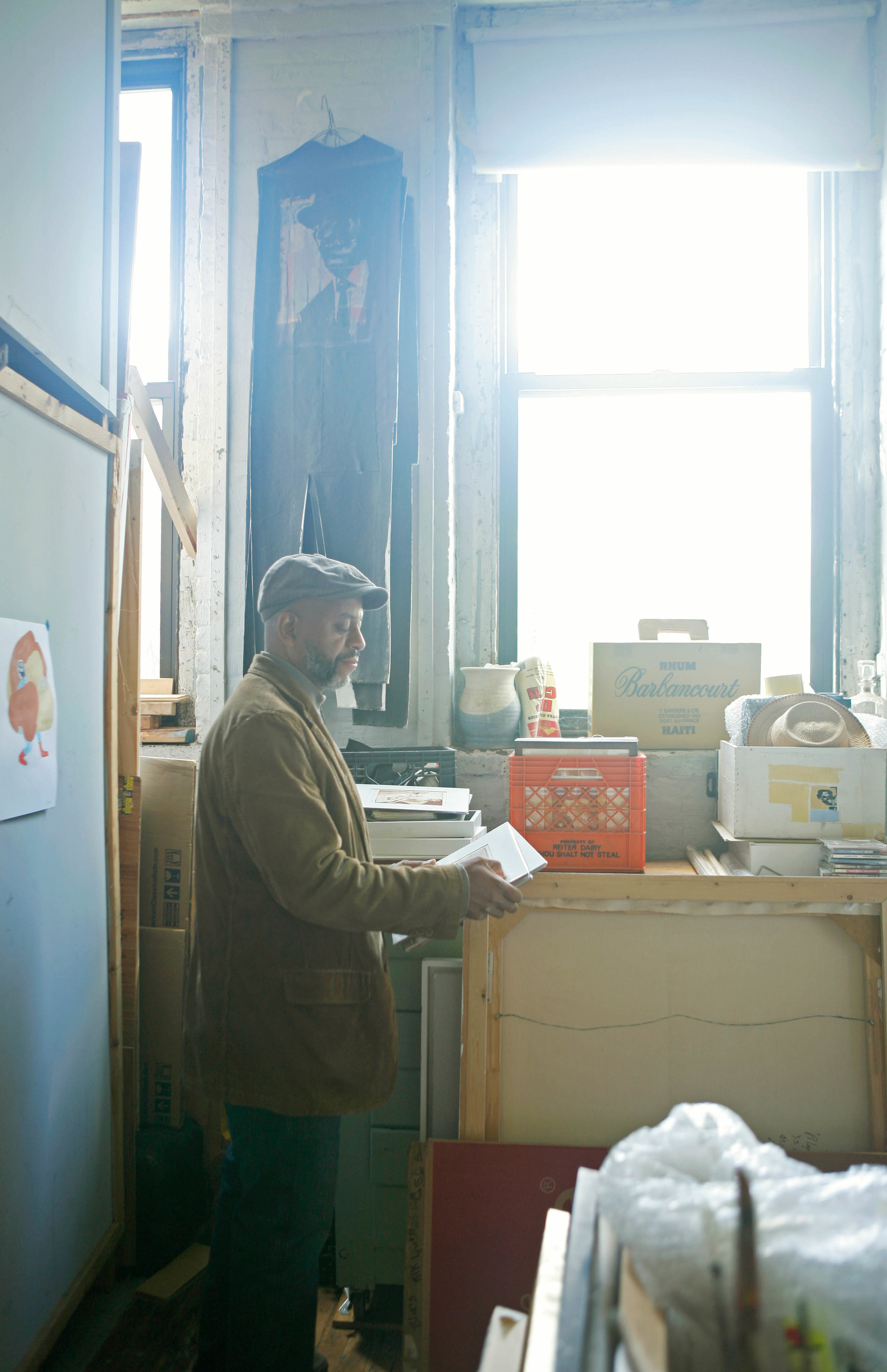The temperature that day was chilly, but the sky was blue and bright and the atmosphere inside the studio of Francks Deceus was welcoming, warmed by his paintings. Walking into his studio we were immediately hit with a sense of who Francks Deceus is as an artist. A multitude of pieces encompassed the studio, filling up the walls and crowding the floor revealing the artist's diligent and dedicated work ethic, perhaps a reflection of his upbringing in a hardworking immigrant family. Iteration after reiteration of similar pieces shows Deceus' process of constantly reworking and refreshing his narrative to get at just the right voice.
As we spoke we learned of the importance of his Haitian background in his work, his interest in human relationships, and the importance of mixing and separating business and art.
Has your cultural background influenced your art?
Well as a Haitian American artist I am always struggling, as how to infuse my Haitian identity in the work. This is because I am trying to maintain explicit social and cultural ties to more then one place at the same time. I believe that one's cultural background is a key element in making work that is both challenging and inspirational.
Growing up, he was naturally drawn to art. Choosing a medium he could best relate to, he started drawing superheroes and comic book scenes, which then led him to creating his own character: Afroman. Conceived with the idea of having cultural representation within the very unequal world of comic book characters, even then, young Deceus was looking towards a narrative that spoke to his own self identity and its interaction within the outer world. That self-portrait comic character has not quite left his mind appearing in various forms of his work clad in everyday workmen wear and rubber boots.
When did you choose art as a career and why?
I didn’t, art chose me, it was just something I did because it was fun, it sort of happened over time in a very organic fashion.
Was there ever an alternative career choice? If yes, what was it?
As a kid I wanted to be an Architect but I was never able to make the commitment because at the end of the day, my true calling was painting.
What was the first art work that you sold? How did that sale make you feel?
My first sale was at a store front gallery on Fulton street, I believe the year was 1994, the painting was less then five hundred dollars but it may have been a million, because that how amazing it felt.
Who is your favorite artist?
My favorite artist would have to be Jean Michel Basquiat, mostly because he changed the game, with his dramatic artistic style and his mainstream success.
What or who inspires you and why?
I am mostly influenced by a desire to create works that I can be proud of, that offer a viewpoint on the world that people can respond and react to.
Pick one: bike, car, bus, train.
Bike.
Minimal, yet bustling, quiet, yet verbose, Deceus' work contains an interesting duality that captures the viewer and forces them to stop and think. As we peeked back at his older pieces, while being surrounded by his current, unfinished work, a very strong narrative of a migrant people arose. Deceus explained to us his interest in human relationships and the way catastrophic events bring those of all cultures, similar and dissimilar, together.
How has your art evolved over the years?
Over the years my work has changed from figurative to more of a semiabstract format, largely due to my own personal growth and development.
You have the total freedom to determine your own artistic direction. How do you arrive at the point where you commit to a theme or idea?
I arrive at the point------commit to an idea mostly due to trial and error, or what I call happy accident. My work process normally starts with one idea and then I let it go, meaning I would create a series of study’s which would consist of five to ten drawings based on the same idea, and narrow it down from there.
Viewing his work, we were left with the very strong impression of this story. From beginning we start to see figures coalesce and descend, moving together in strong colors and shapes that blend and contrast to create the quiet hum of intersection. An interesting aspect of his work is the subtle use of collage within his paintings created by using gesso and small strips of canvas to create subtle texture and depth to each.
Pick one: cons, vans, pro-keds or jordans
Cons…..
At what time of the day/month/year do you work best?
I used to love working at night. My peak hours of creativity were between 6:pm and 2:am, during the spring summer and fall. I didn’t like winter because the oil paint would harden up and take a long time to dry. However nowadays as a father of two, I have quickly realized that, that was a luxury and I now paint when permitted. In some ways its better because I focus more when I am in the studio and spend less time B-sss-ing.
Do you ever think about where a piece will end up and does that influence the outcome of the art?
No because it’s a waste of time thinking about things I can do nothing about…
What is the most unconventional material you've used in your work?
Bicycle inner tubes to make 3-d art.
What country/state/city/neighborhood do you live in? Where else have you lived?
[Deceus lives in Brooklyn, NY where he moved to from Haiti with his parents when he was young] In 2007 I lived in Paris for a few months during an artist residency program at the Atlantic Print studio in Gentilly France.
What is your favorite meal? Can you cook it? Can you send us a pic of the last meal you made?
My favorite meal is Black rice and Creole style red snapper that my cousin makes once a month at her house in Brooklyn, but sadly I can't make it, not the way she can!
Any upcoming shows/exhibits to mention?
I am putting together a group show of second generation Haitian American artist in the fall, but I am still working on getting a location, please stay tuned.
UPDATE: Deceus' work will be featured in a group exhibition titled "News From The Islands: Six Caribbean Printmakers" at the Tikhonova & Wintner Fine Art Gallery in Harlem from Nov. 7th - Jan. 17th
To see more of Franck's works visit him at his page on Avisca Fine Art or on Facebook and Instagram.
One,
idi Team
Written by: Tatiana Benton & Anishka Clarke; Photography by: Niya Bascom Photography (All rights reserved)




















